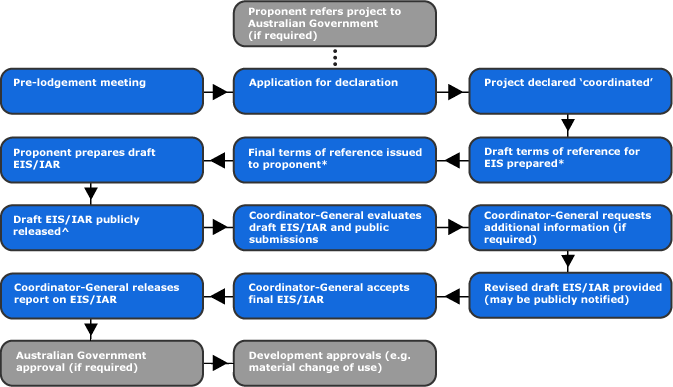The Coordinated Project process
The proponent of a 'coordinated project' must prepare an environmental impact statement (EIS) or impact assessment report (IAR).
The EIS is prepared in accordance with the terms of reference for the EIS.
Steps in the assessment process

* Not applicable for projects requiring an IAR.
^ Public release of an IAR is not required in all circumstances.
Further information about the EIS and IAR process is available in a fact sheet (![]() 126 KB).
126 KB).
Scope of an EIS
The EIS is prepared in accordance with the terms of reference for the EIS. The EIS provides a comprehensive description of:
- the current environment in the area of the project
- all potential environmental impacts of the project
- proponent proposals to avoid, minimise, mitigate and/or offset those potential impacts.
The impacts include direct, indirect and cumulative impacts resulting from the construction, commissioning, operation and decommissioning of the project.
Scope of an IAR
An IAR process may be used if the Coordinator-General is satisfied that the environmental effects of the project do not, having regard to their scale and extent, require assessment through the EIS process. It may be used for well-defined, low-medium risk projects where the likely impacts are highly predictable and the proponent's well-defined proposals to avoid, minimize, mitigate and/or offset those impacts are accepted best-practice in that industry. The IAR:
- has no formal terms of reference
- is focused mostly on the:
- locations that may be subject to adverse impacts if not appropriately managed
- potential impacts that are either uncertain, or
- proposed mitigation measures that depart from accepted management practices or standard conditions for that industry.
What is the 'environment'?
Under the State Development and Public Works Organisation Act 1971, the environment is defined as:
- ecosystems and their constituent parts, including people and communities
- all natural and physical resources
- the qualities and characteristics of locations, places and areas, however large or small, that contribute to their biological diversity and integrity, intrinsic or attributed scientific value or interest, amenity, harmony and sense of community
- the social, economic, aesthetic and cultural conditions that affect, or are affected by, the things mentioned above.
Advisory agencies
The Office of the Coordinator-General manages the state government's evaluation of the project.
A wide range of government departments (known as 'advisory agencies') are responsible for reviewing the draft EIS or draft IAR (e.g. Department of Environment and Heritage Protection). The draft EIS/IAR is also considered by relevant local governments and the Australian Government Department of the Environment.
Other approvals processes suspended
The coordinated project process replaces the information and referral stages of a related assessment under both the Sustainable Planning Act 2009 (SPA) and an environmental authority under the Environmental Protection Act 1994.
The decision stage under both of these Act commences when the Coordinator-General's evaluation report on the EIS or IAR is provided to the relevant assessment.
Last updated: 09 Nov 2021
